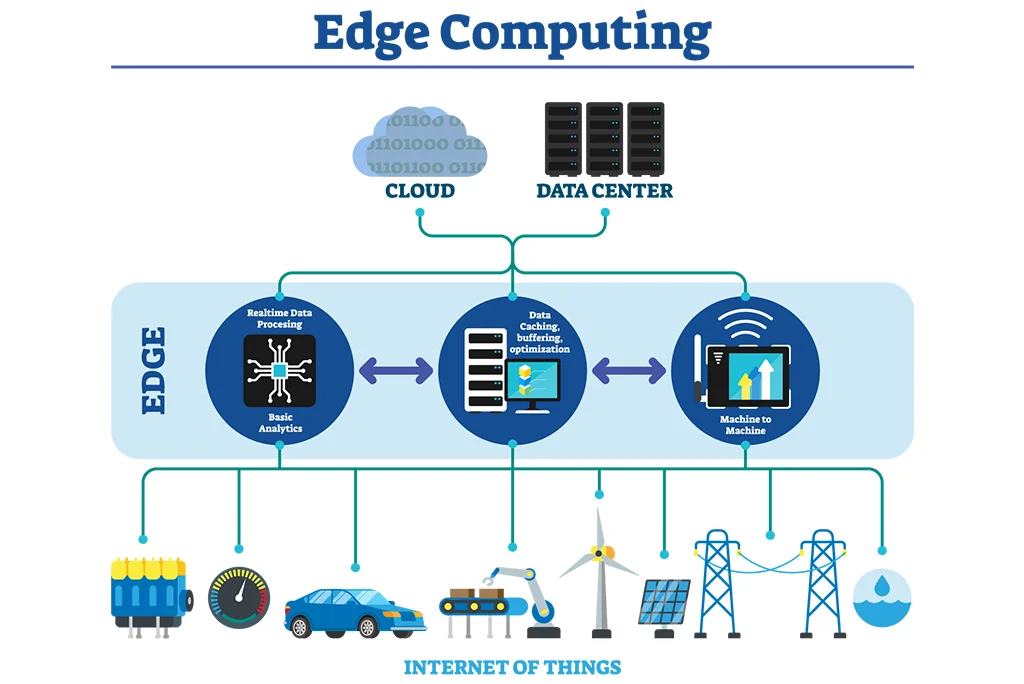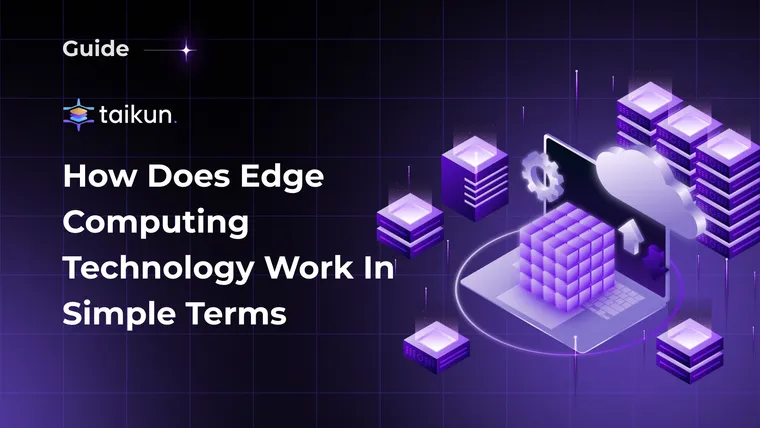One saving grace of high-speed internet is that it allows you to access data stored elsewhere. So, what does this have to do with the future of technology?
Edge Computing (EC) attempts to bridge the gap between our computers, phones, or other devices and the cloud. All the world’s data isn’t just sitting up in the cloud; companies are figuring out how to let us download without going through a cloud server.
This is called “edge” computing because it occurs on the network’s edge—that is, where your hardware lives.Edge computing has taken the world by storm. The technology is poised to revolutionize how we access and use data globally.
In 2022, the market for edge computing was estimated to be worth 11.7 billion dollars. The market is anticipated to be worth 45.4 billion dollars by 2028. The adoption of the Internet of Things (IoT) is the main driver of this rise.
This article will examine how Edge Computing works and how it might be used for businesses.
An Overview of Edge Computing Technology
Edge computing is processing data at the edge of a network rather than sending it to a centralized location for processing. The goal is to improve latency and reduce costs by allowing data to be processed near where it is generated.
Edge computing involves using small, low-power devices that perform some tasks locally rather than sending all data to cloud servers for processing. Many companies are already using edge computing to increase efficiency and reduce costs.
Forecasts suggest that the size of the worldwide edge computing market will increase significantly over the next few years, from 3 billion US dollars in 2020 to 12 billion US dollars by 2028. The Internet of Things (IoT) refers to the growing number of devices connected to networks that collect and exchange data with one another without human intervention.
IoT devices include smartphones, smart watches, cars, and home appliances like refrigerators and washing machines. As more IoT devices become linked, there will be an increasing need for efficient ways to manage the resulting flood of data.
That’s where edge computing comes in: It allows companies to analyze data at the edge of their networks instead of sending all information back to centralized servers for analysis.
How Does Edge Computing Work?
Edge computing aims to make IoT devices more efficient by reducing latency and bandwidth requirements for cloud-based services.

Let’s break down the working process of edge computing to know more about it:
Capturing Data Proximity
Edge computing functions by capturing and processing data as close to its source. This approach minimizes latency and enhances real-time capabilities. It involves sensors, computing devices, and machinery collecting data and transmitting it to edge servers or the cloud.
Data Processing Options
The data gathered can serve various purposes depending on the intended task and outcome. It might be fed into analytics and machine learning systems, enabling automation or providing insights into the status of devices, systems, or products.
The transition from Centralized Cloud Processing
Traditionally, data calculations have occurred in centralized cloud environments or data centers. However, with the adoption of edge computing and IoT devices, the focus shifts to deploying edge servers, gateways, and other infrastructure that reduces the distance and time required for computing tasks.
This often involves setting up smaller edge data centers in secondary cities or rural areas and utilizing adaptable cloud containers.
Diverse Edge Network Technologies
Edge computing encompasses a range of technologies that form an edge network.
These include:
- Mobile Edge Computing: Leveraging wireless channels for processing.
- Fog Computing: Utilizing cloud infrastructure and storage to position data optimally.
- Cloudlets: Ultra-small data centers designed to provide localized processing.
Versatility and Scalability
An edge computing framework brings flexibility, agility, and scalability to various business scenarios. For instance:
- Sensors can offer real-time vaccine storage temperature updates, ensuring transport compliance.
- IoT devices and sensors track traffic patterns, delivering immediate insights into congestion and optimal routing.
- Motion sensors with AI algorithms can detect earthquakes and trigger early warnings, allowing safety measures like gas supply shutdowns to prevent potential hazards.
Empowering Real-Time Functionality: How Edge Computing Overcomes Key Challenges
Edge computing overcomes three connected issues that prevent smart apps and IoT devices from functioning in real time:
Connecting a Device to a Network from a Remote Location
In traditional cloud computing models, devices communicate with centralized data centers, often far away. However, edge computing connects devices to a network incorporating localized computing resources. This means that devices can communicate directly with nearby edge servers or devices without relying solely on distant data centers.
This proximity reduces the latency of transmitting data over long distances, making it particularly beneficial for applications requiring real-time responses, such as industrial automation, remote monitoring, and autonomous vehicles.
Slow Data Processing Due to Network or Computing Limitations
Edge computing addresses the challenge of slow data processing by offloading computational tasks from devices to edge servers.
When a device generates data, instead of sending all of it to a central cloud for processing, edge servers handle initial data analysis and filtering. This process involves pre-processing the data at the edge, extracting relevant information, and sending only essential insights or results to the cloud.
The need to transmit large volumes of raw data over the network is reduced by performing preliminary analysis at the edge. This approach significantly minimizes latency and ensures that only meaningful data is sent to the cloud, optimizing bandwidth and overall system performance.
Edge Devices Causing Network Bandwidth Issues
Network bandwidth can become a bottleneck in scenarios where numerous edge devices generate data simultaneously. Edge computing mitigates this issue by distributing data processing tasks across a network of edge devices and servers.
Each edge device contributes to the processing load, handling data generated within its immediate vicinity. Distributing the workload across multiple devices alleviates the strain on the network, and data can be processed more efficiently.
This approach also promotes fault tolerance; if one edge device fails, others can continue processing tasks, enhancing the system’s overall reliability.
Benefits of Using Edge Computing
In addition to supporting real-time decision-making, edge computing has many other benefits:
Enhanced Data Privacy and Security
Edge computing provides enhanced security because it’s located closer to end users, which means fewer points of vulnerability along the way. It also makes it easier for companies like yours to protect your customers’ privacy because there’s less distance between their devices and your servers.
Bandwidth Efficiency
Edge computing reduces network traffic by moving processing closer to where data is generated or captured. This allows you to optimize bandwidth usage by performing tasks locally without sending information over long distances.
Reduced Latency and Faster Response Times
When trying to build a mobile application that can communicate with other devices, your app must have a low latency rate. A high latency rate makes it difficult for users to interact with your app because they’ll have to wait longer for their request to be processed by your server.
Using edge computing, you can reduce latency rates by sending data directly from your device to another without going through intermediary servers first. This will make it easier for users to interact with your application and finish their work faster.
Improved Reliability and Resilience
If you run a service requiring real-time data processing and analytics, then edge computing can help make it more reliable. You no longer have to rely on the cloud or the internet for all your computing power needs.
This makes your services much more resilient because if one provider goes down, you can still access your data and continue doing business as usual.
Real-time Data Processing and Analytics
Edge computing also allows you to process data at the source rather than traveling back to the cloud before being processed. This means that you can get real-time results faster than ever before!
Drawbacks of Edge Computing
While edge computing offers numerous advantages, it also presents several drawbacks.
- Maintenance Challenges: Remote management and maintenance of dispersed edge devices can be logistically complex.
- Lack of Standardization: The diversity of edge devices and architectures can lead to compatibility and integration issues.
- Scalability Constraints: Scaling an edge computing network might require significant adjustments to ensure optimal performance.
- Dependency on Connectivity: Edge applications can suffer when network connectivity is lost or intermittent.
- Data Integrity Risks: Storing and processing data at the edge can expose it to greater risks from physical damage or unauthorized access.
- Increased Complexity: Managing a hybrid environment with cloud and edge components can introduce complexity to IT operations.
- Skill Requirements: Implementing and maintaining edge solutions necessitates specialized skills that might need to be more readily available.
- Limited Central Control: Centralized control and monitoring can be challenging in a decentralized edge environment.
- Energy Consumption: Some edge devices may lack efficient energy consumption mechanisms, impacting sustainability efforts.
- Integration Efforts: Integrating edge solutions with existing systems can require substantial effort and potential disruptions.
Elevate Your Edge Computing Experience with Taikun
Understanding how edge computing technology works opens doors to a new era of real-time capabilities and efficiency. As you navigate this dynamic landscape, consider harnessing the power of Taikun, your ultimate cloud automation platform.
Elevate your DevOps teams’ productivity through real-time monitoring, automated CI/CD pipeline creation, and management optimization. Taikun empowers organizations to deliver unparalleled user experiences while fortifying security and data protection. Experience innovation like never before. Explore Taikun today for free or consult with our experts to receive personalized guidance.


